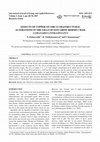Papers by K. MUTHUKUMARAVEL, P. KUMARASAMY,A. AMSATH and M.GABRIEL PAULRAJ
International Journal of Entomology Research, 2021
International Journal of Entomology Research, 2021
International Journal of Entomology Research, 2021
The study was conducted to investigate the effect of sublethal concentration of heavy metal Arsen... more The study was conducted to investigate the effect of sublethal concentration of heavy metal Arsenic (NaAsO2) exposure on<br> haematological parameters such as red blood cells (RBC), Haemoglobin (Hb), white blood cells (WBC) and clotting time<br> (CT) in the blood of fresh water fish, Channa punctatus. The present study shows the level of RBC and Hb were<br> significantly decreased simultaneously the WBC significantly increased due to arsenic exposure. While the clotting time<br> also increased with exposure. Thus the present study concludes that the hematological parameters of fish of Channa<br> punctatus affected by exposure to arsenic. Further the duration of exposure determines the rate the impact on blood<br> parameters.

Vector-borne diseases caused by mosquitoes are one of the major economic and health problems in m... more Vector-borne diseases caused by mosquitoes are one of the major economic and health problems in many countries. Vector control methods involving use of chemical insecticides are becoming less effective due to the development of insecticides resistance, biological magnification of toxic substances through the food chain, and adverse effects on environmental quality and nontarget organisms including human health. Today, nanotechnology is a promising research domain which has a wide ranging application in vector control programs. In the present study, the mosquito adulticidal activity of silver nanoparticles (AgNPs) synthesized using Chomelia asiatica plant extract against three important adult female mosquitoes of Anopheles stephensi, Aedes aegypti and Culex quinquefasciatus was determined. Range of concentrations of synthesized AgNPs (12, 24, 36, 48, and 60 ppm) and leaf extract (70, 140, 210, 280, and 350 ppm) were tested against the adult mosquito of An. stephensi and Ae. aegypti a...
The freshwater fish Mysstus vittatus was exposed to 10% and 30% sublethal concentrations of (LC50... more The freshwater fish Mysstus vittatus was exposed to 10% and 30% sublethal concentrations of (LC50 for 96 h - 0.0036 ppm) cypermethrin for a period of 10, 20 and 30 days to study the effect of cypermethrin on the biochemical composition of various organs such as muscle and liver. After stipulated time, the carbohydrate, protein and lipid content in the various tissues of Mystus vittatus under pesticide stress were found to be decreased when compared with control.

Acute toxicity (96 h LC50) of lead arsenate was evaluated in the Cirrhinus mrigala in static bioa... more Acute toxicity (96 h LC50) of lead arsenate was evaluated in the Cirrhinus mrigala in static bioassay over a 96 –h exposure period using probit method. The 96 h LC50 values (with 95% confidence limits) of lead arsenate for fingerling fish were estimated as 7.21 mg/l respectively. Histopathological investigations revealed various degrees of pathological lesions in different organs like gill, liver, intestine and kidney. The gill showed the fusion, malformation of secondary lamellae at the tips, vaculation, hyperplasia and disintegration of epithelium. The liver of fish exposed to phenol showed cytoplasmic vaculation, necrosis and loss of hepatic cell wall. In the intestine, necrotic lesions in the epithelial layer, swellings and fusion with adjacent villi, fusion and integration of columnar epithelial layer. The kidney showed shrinkage of glomeruli, breakdown of Bowman's capsule, vacuolization and disintegration of renal epithelium. The histological alterations in the fish could ...

To study the histological changes of the gill due to copper in the estuarine hermit crab Clibanar... more To study the histological changes of the gill due to copper in the estuarine hermit crab Clibanarius infraspinatus in effects of chronic exposure for 10, 20 and 30 days were examined under the light, scanning and transmission electron microscopy. The experimental setup was made the 30 x 30 x 50 cm at temperature 28±1 ºC, pH 7.9±0.2, 27±1 ppt salinity and 5.6±0.2 mg/l dissolved oxygen. The LC50 of copper 5, 6, 7, 8, 9 and 10mg/L concentration level added with 5L of water. The mortality was 24, 48, 72 and 96 h and the LC50 1/10th for 96 h was taken as the SL study for 30 days of exposures hermit crab selected following this histological studies. In Light Microscope at 58-60°C, the SEM and TEM. The effects of chronic exposure for 10, 20 and 30 days to 10% sub lethal(SL) concentration of copper 96 hr LC50 - 8.547 mg/l; 10% SLC 0.8547 mg/L). The present ultra structural alterations were remarkable during the exposure period revealed changes observer serve as "biomarkers" for as...
International Journal of Pure and Applied Zoology, 2013
Experiments were conducted to study toxic effect of sodium arsenate on haematological parameters ... more Experiments were conducted to study toxic effect of sodium arsenate on haematological parameters of the freshwater catfish Mystus vittatus. LC50 value of sodium arsenate was calculated for a period of 96hrs. M. vittatus exposed to sub lethal doses such as 0.15, 0.75, 1.5 and 2.0 ppm sodium arsenate. Sodium arsenate toxicity induced a significant decrease in Haemoglobin content, and RBC count and increase in WBC count.
E-Journal of Chemistry, 2007
The present study was carried out to determine the sub lethal toxic effects of the heavy metal ca... more The present study was carried out to determine the sub lethal toxic effects of the heavy metal cadmium on the electrophoretic protein fractions of gill and muscle tissues ofOreochromis mossambicus. Fishes were exposed to 10% sub lethal concentration (96 h LC50) of cadmium for a period of 10 days. The protein fractions in the muscle of experimental fishes were found to be increased (twelve fractions) with respect to controls (eight fractions). The numbers of protein fractions in the gills of test fishes were found to be lesser than the control fishes. The results of the present study prove that cadmium affects the protein fractions in the tissues of fishes.

E-Journal of Chemistry, 2008
Municipal solid wastes are mainly from domestic and commercial areas containing recyclable toxic ... more Municipal solid wastes are mainly from domestic and commercial areas containing recyclable toxic substances, compostable organic matter and others. With rapid increase in population, the generation of municipal solid wastes has increased several folds during last few years. Disposal of solid wastes can be done by methods like land filling, incineration, recycling, conversion into biogas, disposal into sea and composting. Vermicomposting is one of the recycling technologies which will improve the quality of the products. The present study aims to find out the possibility of utilization of vegetable wastes for vermiculture. EarthwormMegascolex mauritiicultured in plastic trays (45 x 30 x 30 cm) containing soil alone (control) (T1), soil + cow dung (T2), soil + vegetable waste (T3) and soil + vegetable waste + cow dung (T4) for 60 days. Nutrient values were determined from the compost and compared with that of the control. From these results, it was found that NPK values were maximum i...
Int J Ecol Environ Sci, 1999
The present study was carried out to investigate the LC 50 of two different pesticides such as mo... more The present study was carried out to investigate the LC 50 of two different pesticides such as monocrotophos and lambda cyhalothrin on the freshwater fish Labeo rohita. Monocrotophos caused 100% mortality of L. rohita at 0.0044ppm and 50% mortality (96 hours) at 0.0036 ppm, and for lambda cyhalothrin, the lethal effect was at 0.0029 ppm and LC 50 at 0.0021 ppm. The LC 50 values obtained at 24, 48, 72 and 96 hours exposures and the 95% confidence limits for the two pesticides revealed that lambda cyhalothrin showed higher toxicity than monocrotophos. The LC 50 values of monocrotophos for 24, 48, 72 and 96 hours were 0.0041, 0.0039, 0.0037 and 0.0036 ppm respectively, whereas the LC 50 value of lambda cyhalothrin for 24, 48, 72 and 96 hours were 0.0026, 0.0024, 0.0022 and 0.0021 ppm, respectively.
Journal of Orthoptera Research, 2000

Biocatalysis and Agricultural Biotechnology, 2015
Abstract The seasonal abundance and spatial distribution of ichthyoplankton in relation to enviro... more Abstract The seasonal abundance and spatial distribution of ichthyoplankton in relation to environmental parameters were made from October 2011 to September 2012 in the estuarine and coastal waters of Coleroon. A total of 25,810 finfish eggs were collected in the Coleroon estuary belonging to 7 orders which include 24 families and 46 taxa. Majority of the eggs represents the order of Perciformes (13 family) followed by Culpeiformes (5 family), Mugiliformes, Anguliformes, Tetradontiformes, Atheriniformes, and Gonorhynchiformes (1 family form each order). In addition, a total of 11,320 finfish larvae also were collected belonging to 7 orders which include 24 families and 45 taxa, the majority of the group belongs to the order of Perciformes (15 family) followed by Culpeiformes (4 family), Mugiliformes, Anguliformes, Tetradontiformes, Atheriniformes, and Gonorhynchiformes (1 family form each order). In the present observation, both eggs and larvae of finfish were higher during postmonsoon whereas lesser number of eggs was recorded in summer and larvae in premonsoon season. The physico-chemical parameters viz., Surface water temperature, salinity, pH, dissolved oxygen, Biological oxygen demand and NH 3 are also provided a relatively stable environment which was favorable for larval production and survival in the Coleroon estuarine region.
The present study an attempt is made to know the distribution of molluscs particularly gastropods... more The present study an attempt is made to know the distribution of molluscs particularly gastropods and bivalves at the coastal village Keezhathottam of Thanjavur District, Tamil Nadu. Gastropods and Bivalves were collected by hand picking. They were examined using various morphological characters for identification. There are 20 species of molluscs were recorded in the present study including the species diversity of 14 Gastropods species and 6 Bivalves species. The diversity of Gastropods compared with Bivalves shows the ratio of 70% of gastropods and 30% of bivalves.
The present study was aimed to examine the diversity and dominance of dragonfly in Muthupet mangr... more The present study was aimed to examine the diversity and dominance of dragonfly in Muthupet mangrove forest in Thiruvarur District, Tamil Nadu was carried out for a period of one year from January 2014 to December 2014. Combine technique sampler (Core and Sweeping net) were used sampling of Odonata. Totally 8 species (Rhyothemis variegata, Anax guttatus, Pantala flavescens, Brachythemis contaminata, Orthetrum sabina, Diplacodes trivialis, Crocothemis servilia and Tramea basilaris) of Anisoptera (dragonflies) were recorded and all these species were grouped into two families. Libellulidae was the dominant family with 7 species followed by Aeshnidae family (1 species). Species diversity and abundance were maximum in the months of monsoon and dropped to the minimum in the months of summer.

The physiological, biochemical and haematological changes in Channa punctatus after exposure to s... more The physiological, biochemical and haematological changes in Channa punctatus after exposure to sublethal concentrations of the copper sulphate of the heavy metal have been investigated. The toxicity of the 2 ppm copper sulphate with respect to behaviour, and haematological paramaters of the fish Channa punctatus has been studied. Red blood cell (RBC) count and haemoglobin (Hb) content were decreased 0.9% with the increasing concentrations of the copper sulphate. However, the white blood cell (WBC) count was increased 1% with increasing concentrations of the copper sulphate. A dissimilar relationship was established with respect to RBC and WBC. The constant increase in the differential count clearly indicates that the heavy metal stress certainly stimulate the white blood cells to produce more at all times of exposure. Biochemical changes of protein, lipid and carbohydrate were recorded. Also, such fish when consumed as food leads to the deposition of the heavy metal in the soft tis...
The effect of sub lethal concentrations of copper on biochemical components such as carbohydrate,... more The effect of sub lethal concentrations of copper on biochemical components such as carbohydrate, protein and lipids were studied in the pacific white shrimp Litopenaeus vannamei up to 30 days at an interval of 10 days. The exposed pacific white shrimp are exhibited differential changes in biochemical constituents. The changes were dependent on the period of exposure and concentrations of copper. The effect of 30% sub lethal concentration was to be pronounced than that of 10% sub lethal concentration.
Journal of Experimental Zoology, India, 2010










Uploads
Papers by K. MUTHUKUMARAVEL, P. KUMARASAMY,A. AMSATH and M.GABRIEL PAULRAJ